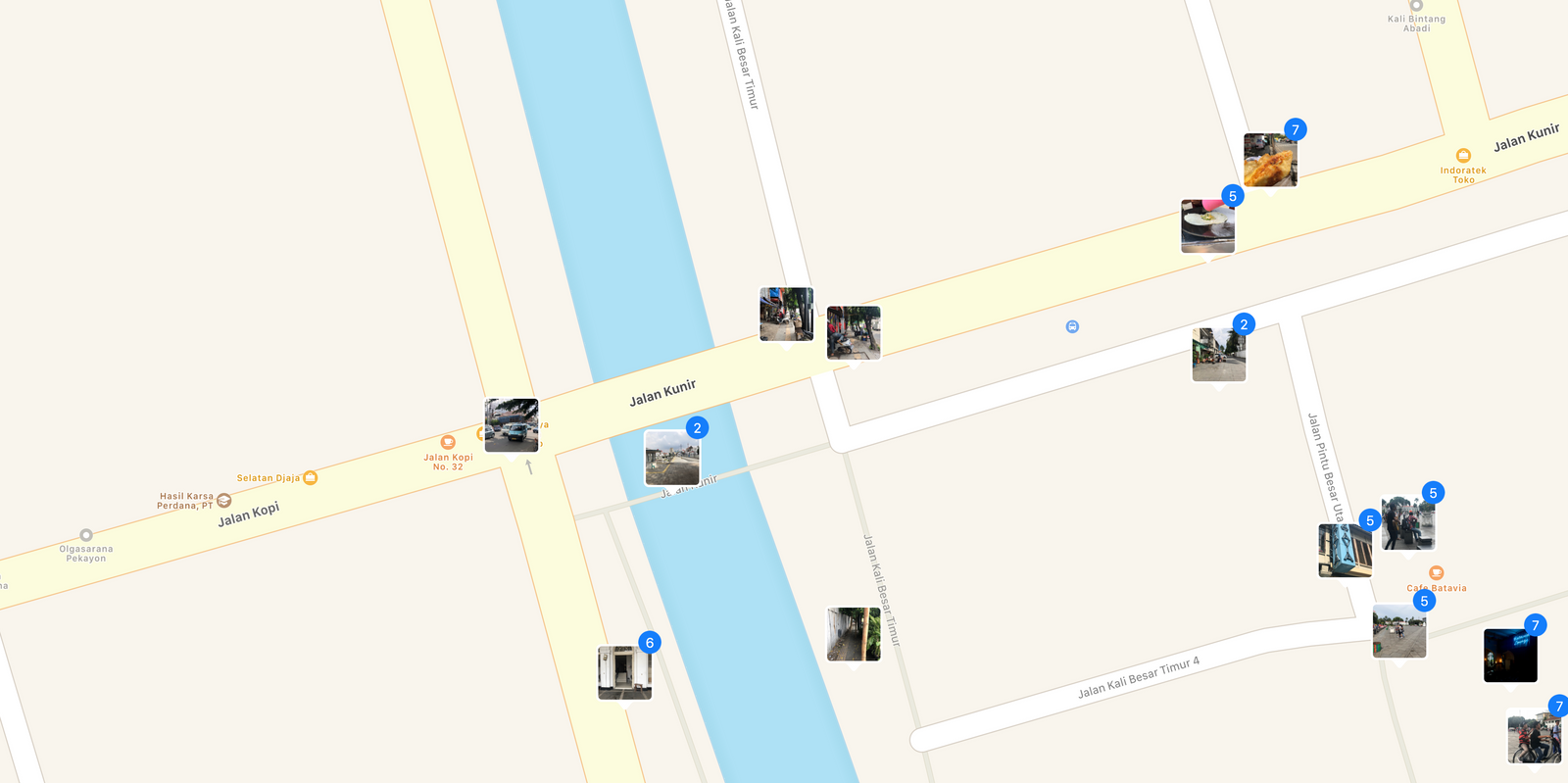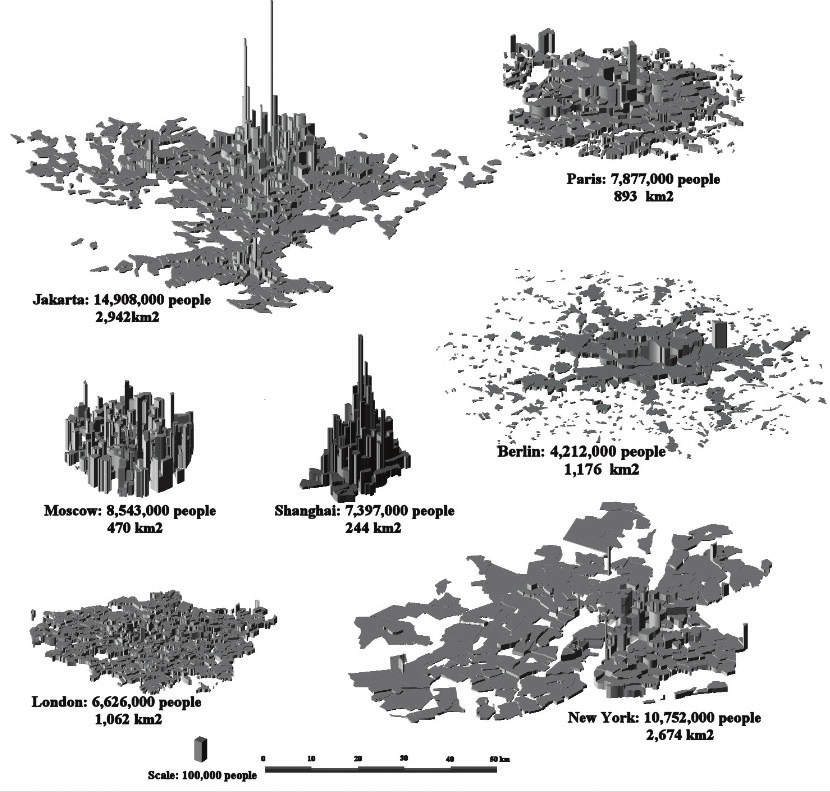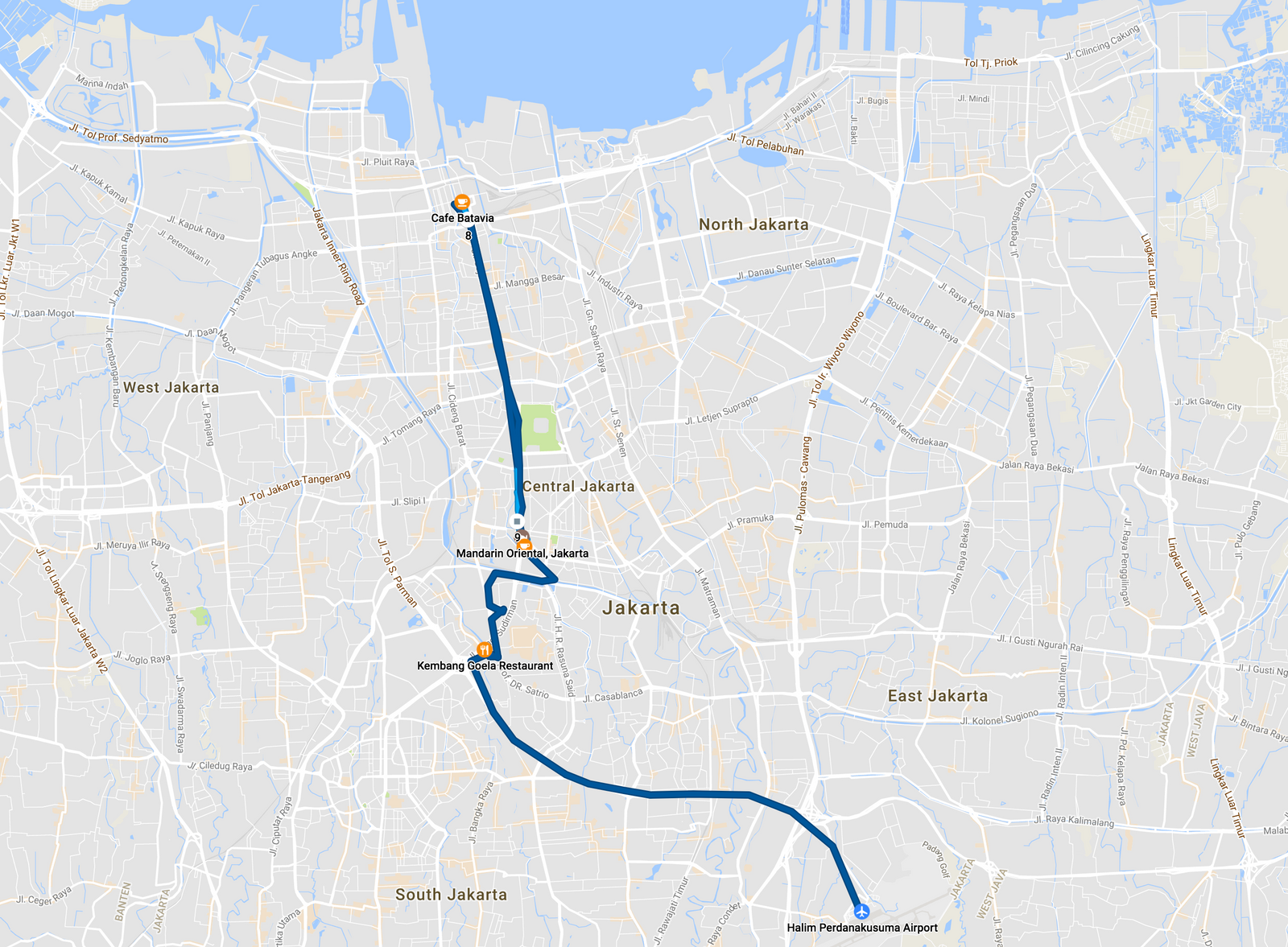City review: A day in Jakarta
May 21st, 2018
I spent Thursday, 8 March 2018 in Jakarta, Indonesia. Of the cities I visited during this trip, Jakarta was the one I disliked most. I try to be as positive as possible on the internet (it's just too easy to be negative), but in this case it would be ingenious. The parts of Jakarta I explored were unpleasant and a bit depressing.
If Las Vegas and Mad Max had a baby...
The main thoroughfare felt more like a highway than a street. This combined with the big, blocky commercial developments gave it a strong Vegas vibe, though maybe a few decades after humanity has bounced back from a minor nuclear war. Something between Las Vegas and Mad Max, but with far less space.
I would have liked to spend more time getting lost in the neighborhoods. I suspect they would’ve felt very different. I tried to wander over to the more winding streets of the city off the main thoroughfare, but it was so difficult to cross the reckless, never-ending traffic that I didn't get very far.
I was also leered at everywhere I went, which did not add to my sense of safety. Upon returning to SF from the trip, I mentioned to a colleague that I'd wandered Jakarta alone for a day, and she looked horrified. She said that was a really bad idea, that kidnappings of foreigners are common and that the general crime rate is just really high. I had no mishaps, so in a way I'm glad I heard this after a chance to see the city firsthand. But in the branching timelines of the multiverse at least a few infinities of Devons did not fare so well.
Everything about the city felt temporary. It felt like it was either in the process of being built or—more often—of being demolished. Construction was everywhere, and it made no effort to contain its externalities. The sidewalks were covered in rubble. In Beijing, the construction was an annoyance, but it felt optimistic and hopeful. Here it felt like a "fuck you" to the residents. (I imagine many Beijingers also feel that way, but here it was more in your face.) Certain parts of Jakarta felt like there’d been a bombing raid of a once-glorious city, especially the areas with pretty whitewashed colonial architecture.
Rubble everywhere
  | Public toilets were Port-A-Potties
  |
Another thing that put me on edge is that high-end establishments (hotels, fancy malls, banks) all had metal detectors at the pedestrian entrance. In the single day I was there I went through several checkpoints around the city where they did random open-door car searches, and I only took a handful of car rides. According to a local I asked, these were relatively new, a response to the 2017 bombings. Another mentioned the 2003 terrorist attacks. These safety precautions felt performative though, as though the security folks were just going through the motions. I doubt they would serve as much of a deterrent to a motivated terrorist.
The cost of this performance seems surprisingly high. I don't so much mean the direct financial cost—the labor to man it is cheap in Indonesia—but it seems like it would deter international businesspeople, whom Indonesia is clearly trying to attract. It makes me question if the government/police really have things under control, and it makes me worry about the general trust level of society. The costs and benefits don’t seem to add up, but maybe it’s just a matter of local vs global incentives. The individual hotel owner wants to look like they care about their customers’ safety. They of course would like people to feel like Jakarta is a safe place to do business that doesn’t require metal detectors, but as long as that’s not true they benefit more from having the protection signal than they’re hurt by it contributing to the overall feeling of instability.
 |  |
Pedestrians not welcome
The pedestrian experience was just so odd. It felt like older parts of the city had originally developed around good sidewalks, strong street life, but then someone decided to block off that access. There were many places where there was a nice path, but it was cut off by a makeshift obstacle that kept me from getting where I wanted to go.
I had a general sense of "if you can’t afford to arrive here by car, you’re not the kind of customer we’re looking for". There were a many spots where the underlying street structure was amenable to pedestrians, but then small changes after the initial development were made to actively inconvenience pedestrians. Terrible pedestrian experience! Wandering Jakarta was the most exhausting and unwelcoming of the five cities, and that's saying quite a lot considering Beijing was in that mix.
 |  |
The sidewalks were kind of cool. In a bunch of places you can look through the cracks to see the sewer underneath. (Photo below!) I have a few guesses as to why they went with this design, though if you have better information please let me know!
- It rains a lot in Indonesia, so the gaps probably aid drainage rather than putting lots of load on a single opening. (God knows we have this problem in San Francisco despite receiving just a fraction of Jakarta's rainfall.)
- I suspect it's cheaper to just put slabs down without carefully sealing them. The downside here is it's a little tricker to walk on.
- Maintenance and replacement is probably easier. If a piece is damaged, they can just lift it out and replace it. On the other hand they're probably more prone to damage, too.
 ..
Incessant construction — exciting and optimistic, but extremely unpleasant
 .
 | Lots of stray cats!
 .
Domination of the street was roughly split between cars and motorbikes.
 .
View from my hotel room
 .
 |
I want to underscore just how difficult it was to cross the street. I'd just been to Ho Chi Minh City two days earlier, which is infamous for traffic that's difficult to traverse by foreigners, and that was a piece of cake compared to this. At least in HCMC there was some pedestrian infrastructure, but in Jakarta it felt like pedestrians were not just an afterthought; they weren't a priority at all. Many sections of the city had no sidewalk at all, and let's just say that wasn't because the streets themselves were welcoming to foot traffic. I have a distinct memory of crossing a small channel on what looked like a footbridge from my map, but when I arrived there were cars and motorcycles speeding through the intersection, and there was no sidewalk. Construction was blocking the way, which made the flow of traffic even more erratic. (For context, I was going from the intersection on the left across towards the right.) What was worse was that I couldn't easily get to a different route. My Uber had dropped me off there, and each direction I could possibly go was totally hostile to pedestrians. So I had no choice but to cross this bridge seething with high-speed traffic.

This short story from the Atlantic about getting lost in Jakarta (about halfway down this article) is right on with my own experience of the city.
I wanted to take a Grab or Uber Moto to get the full Jakarta experience, since they're clearly a primary mode of transport for residents, but I was so exhausted from the harrowing experience of navigating the streets by foot that I decided I just didn't want the stress. I still slightly regret this decision, but at least I'll know my mom would have been pleased with my taking the more conservative decision for once.
..
Density is not a silver bullet
Since coming across this image of Jakarta's spatial distribution of density last year, I was excited to experience it firsthand:

In the US, I generally think of density as closely correlated with interestingness, community, and a feeling of safety in an "eyes on the street" Jacobsian way. The experience wandering around Jakarta disabused me of any notion I might've had that this might be a simple casual effect.
It's intriguing to compare Jakarta to Saigon and Bangalore, both of which are far poorer than Jakarta. The people I interacted with on the street seemed much less cosmopolitan and educated than these two cities, the wealth disparities seemed much more in-your-face and intentional, and it felt like everyone was just trying to create their own little sanctuary out of the hustle and bustle rather than creating inclusionary public spaces. Labor—and life—felt really cheap. One of my big open questions is why that’s the case, especially since wealth is not a good enough explanation.
..
Baby's first BRT 🚌
The highlight of my day was taking TransJakarta, the city's Bus Rapid Transit (BRT) system. It my first BRT ever, and it was even better than I'd imagined. It was also the most functional system I saw in the city. Jakarta doesn't have a subway (yet), so TransJakarta is the primary mode of mass transit in the city. I'd always been a bit skeptical of the claims that BRT could function at a level of service competitive with rail, but I was really impressed. Everything about the experience felt just like using a train, just with squishier suspension. My first trip of the day was in a car, and we were ensnarled by the traffic, but on the way back I took the priority buses. This 30 minute TransJakarta trip was only $0.25 (Rp3.500) and it got me to my destination in about half the time the equivalent Uber would’ve taken. The people watching was far better, too.
Cool underground bus station 😀
 | |
  Loosely held norm to have separate sides for men and women
  The BRT stations looked more like ferry docks than what I usually imagine as bus stops
  Getting out of the stations, which were in the middle of the road, was a bit of a labyrinth.
 |   Love zooming past the rest of the traffic 🚍✊
     Cheap labor => doorman for the bus!  |
..
..
Food
Again I don't think of myself as a picky eater, but I didn't particularly enjoy the food in Jakarta. It was worth trying though! I'll mostly leave you with pictures here:
Spicer than I expected 😳 The next thing I (promptly) consumed was about a gallon of whole milk.
 Fried spagetti instead of a free bread basket! I'd never seen that before.
 This curried lamb was different from most curries I've had. Can't say I'd seek it out in the future, but probably the tastiest traditional food I had in Jakarta.
 | Ostensibly chicken, but it was so fried and coated with sugary sauce that I could barely taste the meat. Not my thing, and definitely not nutritious.
  Hard to see from the photo, but this was a pile of what felt like super dry and hard beef jerky. It was the most highly recommended dish. I didn't really like it, but it was interesting.
 |
At the end of the day, I worked from a hip coffee shop called One Fifteenth for a few hours and almost forgot that I wasn’t in San Francisco. The guy to my left was on a call with Excel pulled up on his laptop screen, and the two women to my right were studying physics. Strange how certain kinds of establishments can be found in every city around the world. They even have an Instagram! So hip.
One Fifteenth Coffee was in this charming, low-slung building.
 The value of a single Indonesian rupiah is so low that almost every transaction is in the thousands, so the ATM machine has a convenient double zero button to speed up entering in values.  | Uh oh, it looks like your embed code is broken. |
There was one public space I enjoyed quite a bit: the big square in the "old town", encircled by Cafe Batavia on one side and the Jakarta History Museum on the other. It was lively and full of all sorts of people. A group of young girls approached me and asked if I could practice English with them. I of course said yes, and they proceeded to pelter me with questions. As soon as the first girl finished, the next girl picked up right after her and to my surprise asked exactly the same questions. This happened with two other girls, and they asked me to take a picture with them. They were very good at English! And very assertive.
     | I got really good at answering these questions after four opportunities to practice!
 Cafe Batavia was a cool sanctuary to escape the heat and get some work done
   |
To be clear, disliking Jakarta is different from being unhappy to have experienced it. I had few priors on Indonesia beforehand, so I certainly can’t complain to have had an opportunity to build intuitions about the capital of the biggest Muslim country. 🙂

Keep in touch!